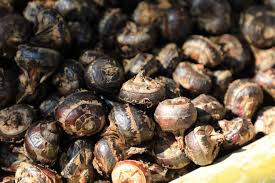Water chestnut (Goer):

Water chestnut, or “goer” in Kashmir, is a vital income source for families around Wular Lake, one of Asia’s largest freshwater lakes. However, environmental changes have led to declining production, affecting local livelihoods.
- Water Chestnut (Goer) in Kashmir Grows in Wular Lake, Kashmir; known as “Singhara” in other parts of India.
- Collected during autumn, typically starting in late September.
- Harvested by villagers using boats, with protective footwear to avoid injuries from sharp barbed spines on the plants.
- The edible kernel is peeled, dried, and ground into flour. It’s widely consumed during festivals like Navaratri.
- Uses:
- Food: White, crunchy, sweet flesh is eaten fresh or dried and used in fasting rituals.
- Fuel: Dried outer shells are used as fuel in traditional Kashmiri fire pots (kangri) during winter.
- Nutritional value: Rich in potassium and fiber, low in sodium and fat, and high in carbohydrates.
- Economic importance: Primarily harvested by poorer communities around Wular Lake; provides seasonal income.




